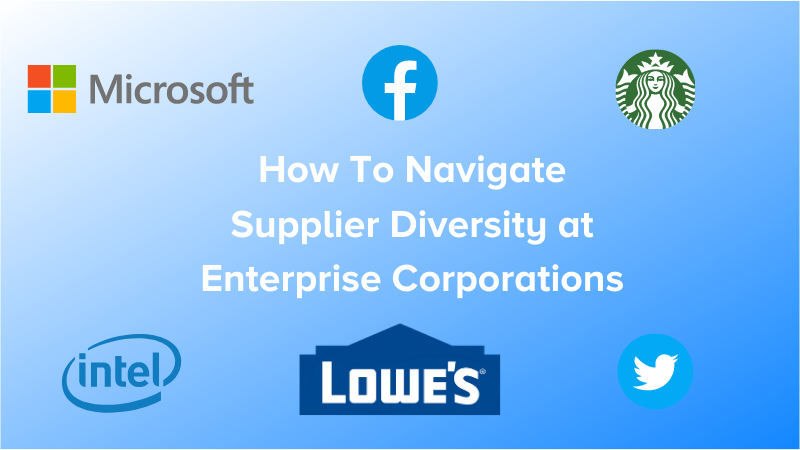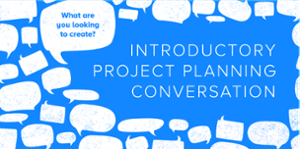
Regardless of your diverse certification status or how big your company is, it can seem daunting to try to get business and work with enterprise-level corporations. We often put big brands on a pedestal and at the top of our goals list.
Luckily, many enterprise corporations have created avenues for diverse suppliers, like VMG Studios, to find opportunities within these dream client companies. As a certified woman-owned business, VMG Studios has been able to create long-lasting relationships through our WBENC certification that has led to an ongoing list of business opportunities.
Like many diverse suppliers, we’ve historically relied on in-person networking opportunities to make connections and facilitate working partnerships with enterprise-level corporations. Since those events were canceled or switched to virtual models due to COVID-19, we’ve all had to pivot our strategies to make such connections.
Naturally, enterprise corporations have also had to shift and adapt their processes for finding and sourcing suppliers.
Earlier this year, VMG reached out to our contacts (some of whom are clients) and conducted a series of interviews with supplier diversity managers at enterprise corporations to learn more about their programs, how they’ve shifted their practices in 2020, and how a diverse supplier can leave a lasting impression.
In the end, we met with supplier diversity managers & heads at 6 enterprise corporations. These specialists included:
- Facebook – Jason Trimiew
- Starbucks – James Hing
- Lowe’s – Tabatha Watson
- Twitter – Kristen Hickey
- Intel – TJ Jackson
- Microsoft – Fernando Hernandez
We wrote a series of articles outlining each individual company, and in doing so, we started noticing some common trends.
In this article, we’re going to look at the 5 biggest takeaways from each of these interviews and provide the ultimate how-to guide for navigating supplier diversity at enterprise-level corporations.
Trend 1: Conduct Research and Provide Value
We heard this across the board during our interviews – suppliers need to conduct specific research about the company they are hoping to partner with to understand how they can best support them.
Kristen Hickey of Twitter said it best. “It’s always important to know who your audience is and to speak directly to that audience.”
What can your business bring to the table that your competitors don’t? How is your company innovating? What timely solutions can you offer?
The supplier diversity managers we talked with offered advice on how to conduct such research:
- Listen to investor meetings
- Review financial reports
- Read company newsroom or blog posts
- Read relevant, timely news articles
- Scroll through social media channels and groups
This is also a good way to see if your company is a good culture fit, as James Hing of Starbucks said.
“What makes Starbucks unique is that we are a relationship-based company. So that extends into our sourcing activities. Who are you? Who are you as an individual? Who are you as a company? We have to see a mirror reflection of our mission and values for us to determine if we can do business with you regardless of what you do.”
Besides providing value and conducting research, the next most common thing we heard in these interviews was…
Trend 2: Don’t Lead With Your Certification
This is a crutch for many diverse suppliers. As a supplier, you might view it as an icebreaker, however, as Jason Trimiew of Facebook succinctly summarized, “If you’re talking to or meeting with a supplier diversity manager, they know you’re a diverse supplier.”
This is where it’s important to do your research and provide value to help separate your company and your service or product offerings from the rest and to offer your insights upfront.
TJ Jackson of Intel said, “You don’t win because you’re diverse, you win because you can compete.”
As they say in the world of journalism, don’t bury the lede.
Trend 3: Build Relationships
Ultimately, this is something you learn in “business 101,” however, it’s something that many of these supplier diversity managers stressed during the interviews.
The big secret they revealed: supplier diversity managers talk to one another.
Fernando Hernandez of Microsoft spoke of this in great lengths saying he belongs to industry groups where they exchange information with other similar types of companies. “I might not have a deal for someone here at Microsoft, but my colleagues over at Apple or Intel or GM might need somebody, so they’re likely going to pick up the phone and say, ‘Hey, Fernando, I need this kind of company.’”
We also had an in-depth conversation on the importance of relationship-building with Tabatha Watson of Lowe’s.
As earlier mentioned, VMG has never done business with Lowe’s, yet our business development team has facilitated a years-long relationship with Watson. We’ve connected with her not to sell, but to add value, exchange ideas, and share best practices. Thanks to this genuine connection, we know Watson would recommend VMG to other supplier diversity managers if she became aware of an appropriate opportunity.
Trend 4: Learn Their Preferred Method of Communication
This is another piece of advice that falls under the “best practices 101” category, however, we found some interesting insights on this topic. Each supplier diversity manager prefers some kind of digital correspondence, such as email, which isn’t a surprise. Gone are the days of playing phone tag – it’s now email tag.
The insights we found interesting, though, were the communications channels that went beyond email. At the same time, the reasoning for these preferred methods makes sense for the individual brand.
Trimiew at Facebook says one of the best ways to get into contact with his team is through Facebook Messenger on the Supplier Diversity Facebook page. Makes sense, right?
Hickey from Twitter surprisingly said no supplier had ever reached out to her via Twitter – an avenue she says she would welcome.
And Hernandez of Microsoft says suppliers should leverage LinkedIn to make connections and build relationships. LinkedIn, by the way, is owned by Microsoft.
Do you see the pattern here?
Taking the extra step to learn a person’s preferred method of communication, especially when you’re utilizing their own platforms, exhibits attention to detail and a commitment to building a cohesive working partnership.
Trend 5: Set Your Company Apart with Video and a Capabilities Presentation
Besides outlining how your company can provide value to these enterprise corporations, showcasing your expertise through dynamic video content and/or a capabilities presentation can solidify your company as a formidable option.
Trimiew says a sizzle reel or explainer video outlining your company’s core offering can help separate you from the pack.
Hernandez, meanwhile, said, “Right now, there’s a small percentage of people who will send me a video about who they are and what their company is all about, and that really breaks through the clutter.”
Also, using video can save you time during matchmaker-type meetings. Often, those meetings are only 15 – 20 minutes – we’ve done a lot of these meetings and we can tell you, that’s a short amount of time to make an introduction, explain your product or services, demonstrate your capabilities, and answer questions.
Hing at Starbucks says another way to showcase value is through customer case studies, while Jackson at Intel says, “What I find personally effective is to have a dynamic capabilities presentation.”
Hickey from Twitter also stressed the importance of a capabilities presentation, specifically when it comes to examples and portfolio work. “The ones that are the most successful are ones that provide specific, relevant examples of how they’ve successfully completed projects that are similar to the projects we (Twitter) would have. They thought about Twitter and what challenges Twitter might have.”
An explainer video and/or capabilities presentation is often the first impression of your company meaning it’s an opportunity to leave a lasting impression.
Supplier Diversity Best Practices
Naturally, no two companies are the same. Each business is going to have different needs, various goals, and unique processes for finding and sourcing suppliers.
However, in our research of these 6 enterprise corporations, we found many parallels that can help diverse suppliers put together a solid strategy from securing meetings to leaving a lasting impression during a (virtual) matchmaker session.
These collated tips include:
- Conduct research and provide value
- Don’t lead with your certification
- Build relationships
- Learn their preferred method of communication
- Use video and a capabilities presentation to set your company apart
By implementing these 5 actionable suggestions, your company, no matter how big or small, has the potential to break through the noise and secure business with dream clients such as the enterprise corporations that graciously took part in these interviews.
If you need help with creative content – such as an explainer video or capabilities presentation – VMG Studios is equipped to elevate your brand to capture the attention of your target client.
Click the image below to schedule an introductory planning conversation with us!
Learn more about navigating supplier diversity at enterprise-level corporations here:






